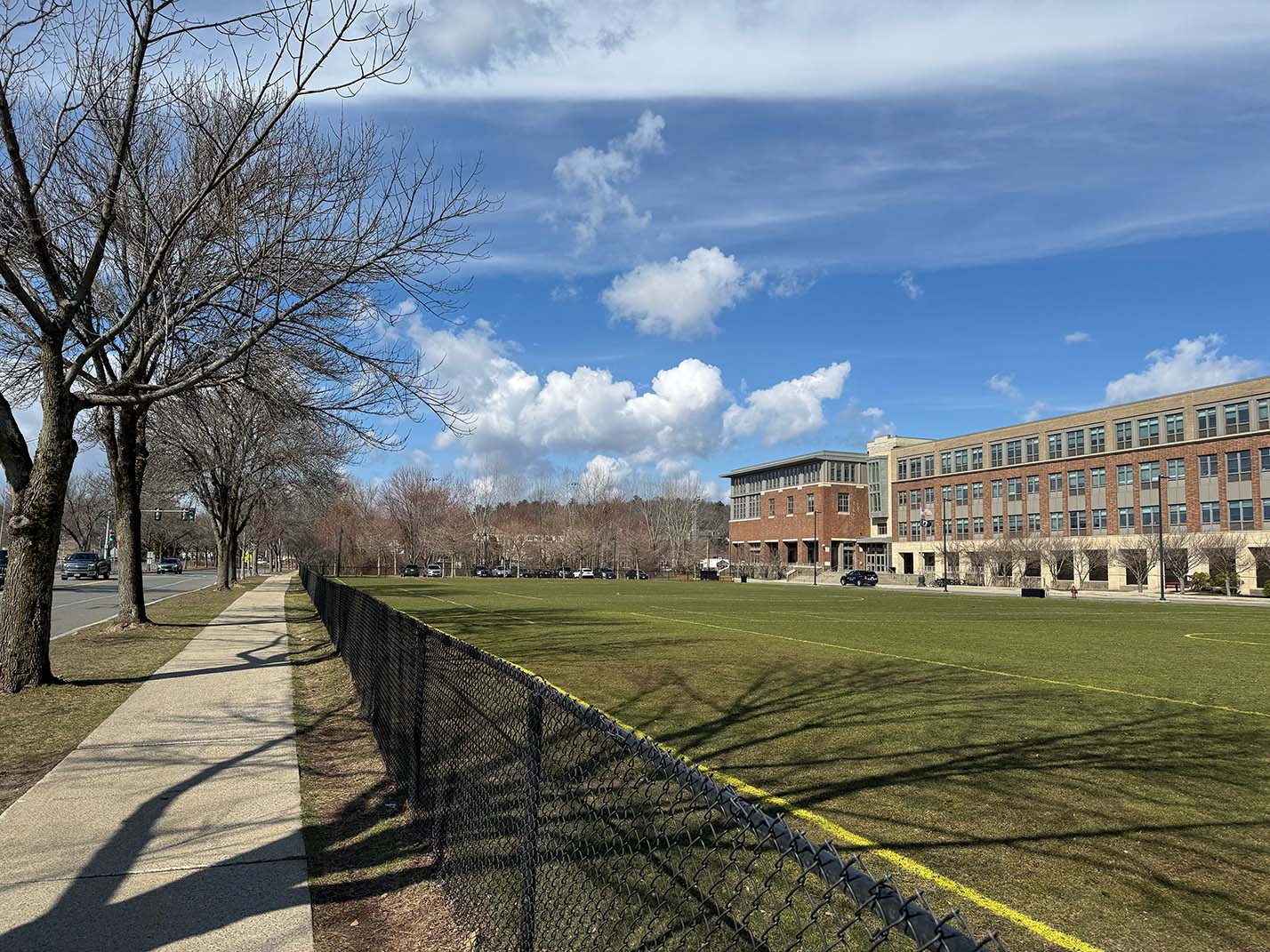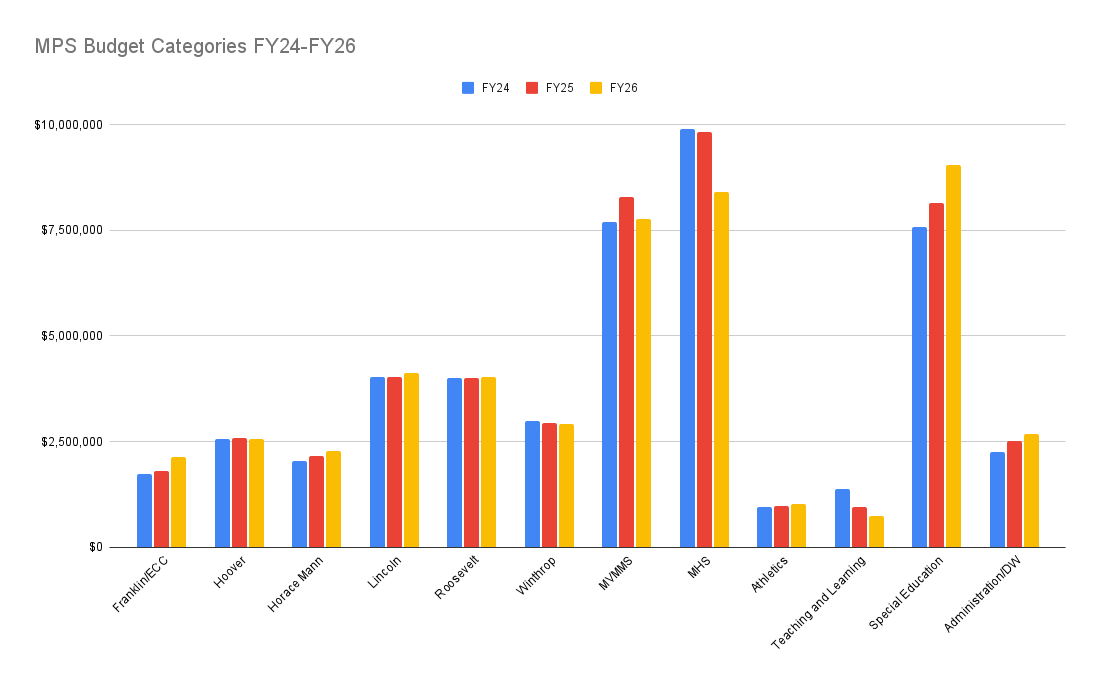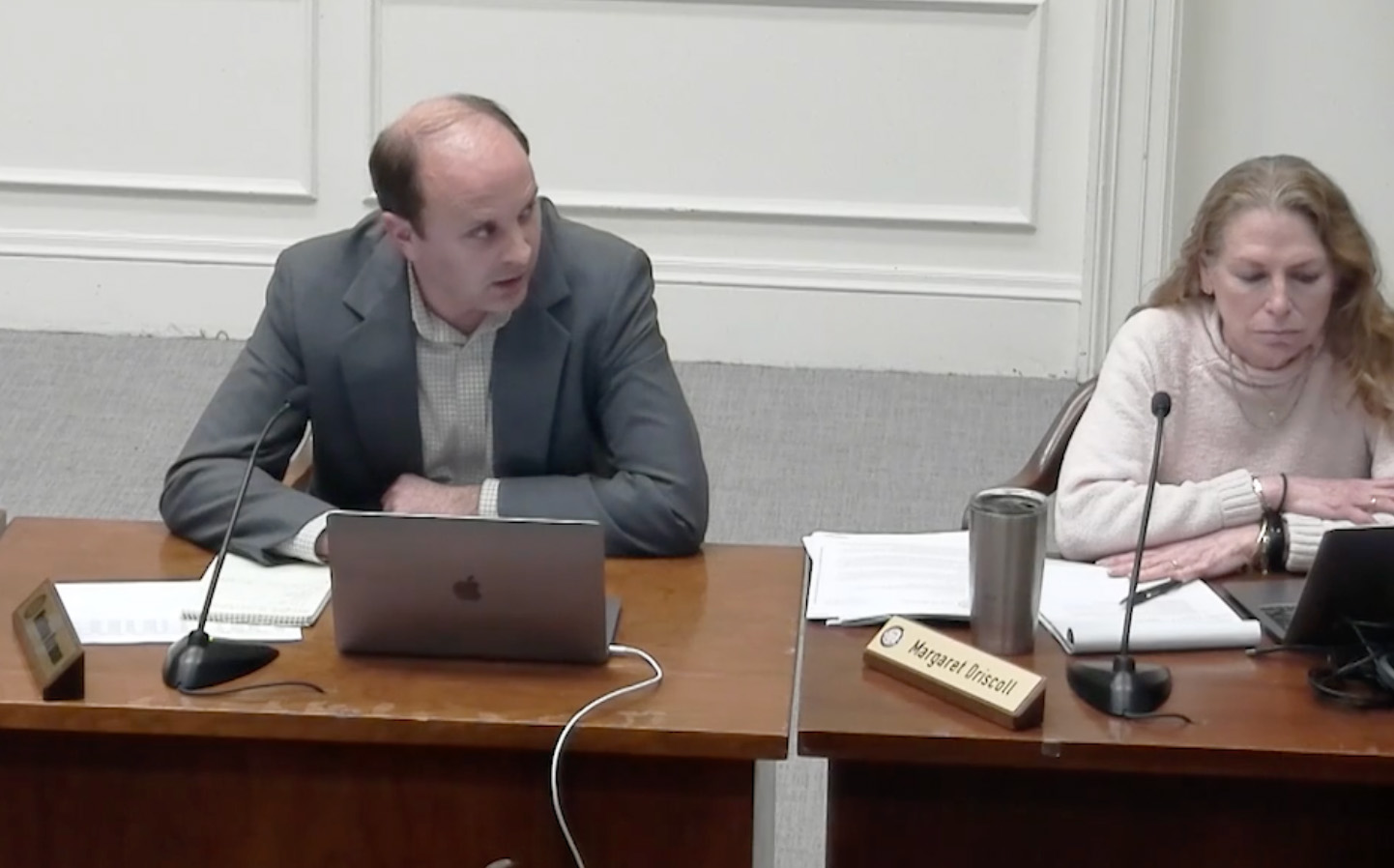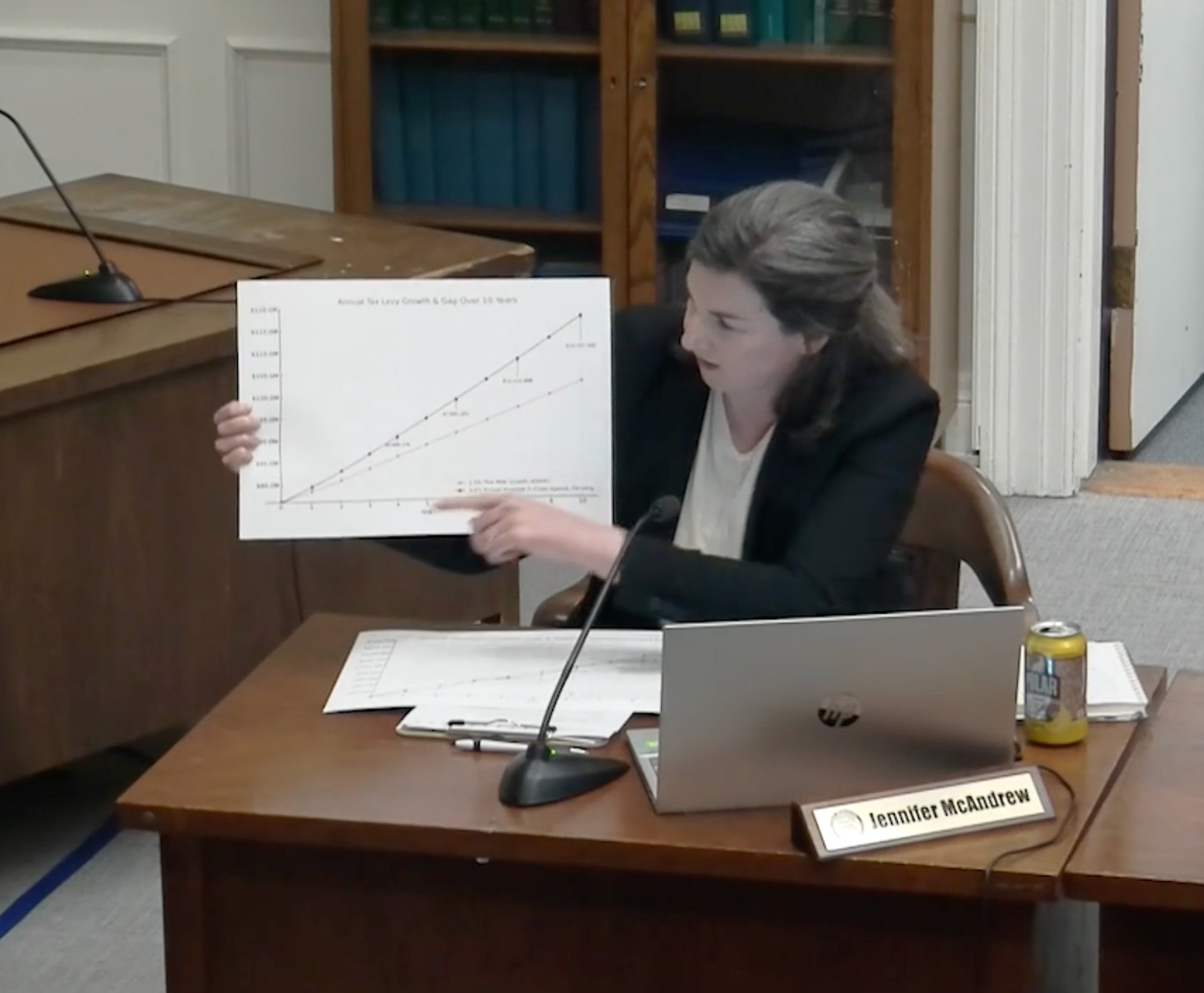School Committee Clashes Over Budget Vote
By Ellen Putnam

Melrose Veterans Memorial Middle School
After heated discussion on Tuesday night, the School Committee voted on a $47.6 million budget for the Melrose Public Schools (MPS) for Fiscal Year 2026 (FY26), which begins in July.
The school budget process began in February when city officials announced that the city and schools are facing a combined $6.1 million deficit for FY26. This is due to rising costs in a number of areas, including health insurance, special education, utilities, and transportation. The city is legally required to pass a balanced budget, so cuts must be made in order to close this budget gap.
Last month, Superintendent Adam Deleidi presented a budget to the School Committee that incorporated $4 million in cuts in order to close the schools’ portion of the budget gap. These cuts include eliminating 31 teacher positions and four administrator positions across the district.
It is the School Committee’s job to vote on how much money to put into each of eight general budget categories. The Superintendent, advised by school principals, is responsible for how money should be used within those categories.
This week’s budget deliberations began with a proposal from School Committee Chair Dorie Withey and Vice Chair Jen McAndrew to move a total of $270,000 out of the Administration/Systemwide and Teaching and Learning categories into the Elementary and middle school categories.

Superintendent's Proposed Budget, By Category
“In my opinion,” explained McAndrew, “every one of these categories is too low for Melrose to function as a school district. But we believe that there will be a need for additional positions at the middle school or secondary level. I do not know how those buildings will run without additional positions. And I’m increasingly worried, based on input we’ve received here and from educators and others in the community, that we’re not appropriately resourcing the youngest grades, either.”
Last year, the School Committee voted to add ten new positions at Melrose Veterans Memorial Middle School (MVMMS), which is the district’s lowest-performing school, even as positions were cut at other schools in the district. Now, all ten of those positions, along with five others, are slated for elimination. Withey and McAndrew’s proposal could potentially bring back two of those.
“I’m going to be blunt,” Deleidi said in response to the proposal, “I fully disagree with this. You have to understand that the plan that we’ve put together here is very fragile. We are looking at $270,000 being pulled from the people who are running the district. I can't run the district this way. I simply cannot.”
“This proposal is enough money to bring back three positions,” he went on. “One at the elementary - so we’d get help in one school, at one grade level. And two at the secondary - we’re looking at class sizes of 28, so this would change it to 27.9. And if it’s a math teacher, it’s really only going to help the math class sizes, it’s not going to help the entire school. If we were going to bring back ten teachers, that would have a substantial impact, but we’re not in that position. So bringing back three teachers and taking away the people who are going run the district, I think is, to be frank, foolish.”

Change in MPS budget categories, FY24-FY26
The Administration/Systemwide category includes the business office, which handles the financial side of the district as well as human resources; the IT office, which includes a director who is shared between the city and the schools; traffic supervisors; and substitute teachers. This category saw an increase from FY25, largely due to some existing costs being recategorized.
“We’re trying to increase transparency,” explained Ken Kelley, the Director of Finance and Administrative Affairs for MPS, in a separate conversation, “and show the community where every dollar goes. We want to make it so our budget aligns with best practice.”
A large part of the increase in the Administration/Systemwide category is due to the addition of a line item of $180,000 for long-term substitute teachers, which hadn’t previously been budgeted for at all. Teachers are contractually allowed to take paid medical leave and use sick days as part of their leave, and the district must also pay for the long-term substitute who covers that absence.
“We’re trying to build a budget that encompasses all of our costs,” Kelley added. “We can’t always plan for how many people are going to go out on leave.”
The Teaching and Learning category has shrunk significantly over the last few years. The FY26 budget eliminates the Assistant Superintendent of Teaching and Learning position, leaving only a Director of Data, Assessment, and Instructional Technology and two new positions - an Executive Director of Student Programming and a Director of Curriculum K-12 - both of which are consolidated from a number of other positions that are being eliminated.

Superintendent Adam Deleidi, left, and Seamus Kelley
Screenshot from MMTV
Deleidi’s proposal to create a new curriculum director position that will combine the responsibilities of two existing director positions (which were consolidated from four positions in FY24) has drawn some criticism, including from Melrose Educators Union President Leslie Means, for prioritizing an administrative position over positions that directly interact with students. Deleidi has responded by arguing that the schools need a minimal level of curriculum support and guidance in order to run at all.
McAndrew suggested that Deleidi could reduce non-salary budget items instead. “Then it’s not about not hiring the curriculum director, or another position. I just feel an obligation to explore every possible dollar that’s available. I also think,” she added, “there are things in this budget that could be funded - not ideal at all, I do not like it, but again, beggars can’t be choosers at some point - that could be funded with one time money for this year, until we see if we get an override.”
An attempted Proposition 2½ override vote for a $7.7 million increase in property taxes failed at the ballot box last June, 55% to 45%. Last month, Mayor Jen Grigoraitis assembled a Financial Task Force, which includes both Withey and McAndrew, to explore including a new override question or questions on the ballot for the municipal election in November.
On Monday night, the Appropriations and Oversight Committee of the City Council approved a number of free cash requests related to the schools, totalling approximately $1.5 million. Grigoraitis indicated that she has set aside an additional $150,000 in free cash that could be used to cover additional one-time expenses for the schools. “It is absolutely a risk to have to go to the City Council and ask them for more free cash,” Grigoraitis told the School Committee, “But I do think they are paying close attention and they are very well aware of our budget process and our challenges.”
What is Free Cash?
Free cash is essentially what is left over from the previous fiscal year's budget, and includes local receipts, which are things like vehicle excise taxes and building permits. The state's Division of Local Services (DLS) recommends that municipalities plan to generate five to seven percent of their total budget in free cash. DLS states that, “As a nonrecurring revenue source, free cash should be restricted to paying one-time expenditures, funding capital projects, or replenishing other reserves.” The amount of free cash a municipality generates can affect its bond rating, which will be especially important for the $130 million public safety buildings project that is currently in progress.
What is a Proposition 2½ override?
Proposition 2½ was a statewide ballot initiative that passed in 1980. It prohibits towns and cities in Massachusetts from raising the total amount they collect in property taxes by more than 2.5% each year, plus an amount calculated to reflect new growth in the town (Melrose’s “new growth” figure for this year will be $770,00).
Municipalities can “override” this limit with a citywide vote to increase the total amount of property taxes the town can raise by a specific amount. The override amount then becomes part of the total property tax base for the following year.
More information about Proposition 2½ can be found here.
In past years, Melrose’s mayor has made a midyear request to fund part of the MPS budget out of the free cash. Grigoraitis intentionally moved away from this practice, which can be seen as fiscally unsound, for FY25. Instead, she has incorporated a larger percentage of local receipts into the school budget, which in turn will decrease the amount of free cash available to the city in FY27 and beyond.
“I recognize this is a bad budgeting practice,” Grigoraitis said of funding recurring school and city expenses through free cash. “We are trying to walk as much of a line as we can, and staying on the right side of good fiscal practice while also trying to keep the lights on and the ship afloat.”
After several rounds of failed motions, School Committee member Matthew Hartman suggested a smaller shift: decreasing administration and teaching and learning by $75,000 each, and moving the $150,000 generated to the middle school, where it could potentially be used to avoid laying off two additional educators. He suggested that Deleidi and Grigoraitis could potentially look into funding some of those cuts through free cash, pending City Council approval.
“This budget that’s proposed in front of you is extremely fragile,” responded Deleidi, “because the positions that we have are already combinations of multiple people. If we cannot have the positions that we’ve proposed, then from an administrative standpoint, those positions are going to fall like dominoes.”
“And if you want to look at the curriculum materials line,” he continued, “I mean, we have to purchase curriculum materials. If we’re using the analogy of the school district as a pizza shop, our product is a pizza. We’re making pizza with no sauce and no cheese. We need curriculum. We’ve cut every dollar out of the curriculum line we can possibly cut. We’re actually below what we need right now. So if we cut more, we won’t have books, and I’m pretty sure our teachers will not be happy that they have to create their own materials.”
“I think it’s really important that we pay attention to what the superintendent says he needs to run the district, because that’s his job, not ours,” said School Committee member Jennifer Razi-Thomas. “And no matter what we do, this is a terrible budget. So we can play games with it, but that doesn’t change the fact that we’re cutting positions that we shouldn’t be cutting because we didn’t pass an override last year.”
School Committee members Margaret Driscoll and Seamus Kelley agreed with this sentiment. “Right now, I put my faith in what has been discussed and presented by our superintendent and our finance director unless and until I hear differently or unless or until there is additional money available to the district in some form or fashion,” said Driscoll. “I believe that the budget before us is the best it can be today.”
“As we’ve gone through the budget over the last couple of months, I have come to appreciate the work that goes into being a superintendent,” added Seamus Kelley. “So I am hesitant to support further gutting the budget that the superintendent has come up with. I’m very concerned about how they are going to run the central office next year.”
“We just ameliorated a 4 million deficit with the proposal in front of us,” Deleidi emphasized, “that doesn’t involve class sizes over 30 or even at 30 at any place. That is a miracle. While we understand that, yes, the middle school needs more resources - so does Winthrop, so does the high school, so does Roosevelt, so does Hoover, so does Horace Mann for that matter. We need more resources across the board. This current plan puts the middle school and the high school at average class sizes of 28. While that is higher than we’re used to, many other districts have class sizes in those numbers. It is not a crisis. I’ve been in districts where we’ve had 34, 35, even 37 in a class.”

Matthew Hartman, left, and Margaret Driscoll
Screenshot from MMTV
“I’m opposed to taking money out of the lines that we’re proposing taking money out of,” he went on, “because that puts us in a bind. I’m going to have a very challenging and difficult time running this district with $100 less than what’s in those lines. We need people to drive the ship, and we need resources and materials, and we do need people in the business office, because I’m going to tell you what ends up happening is when those things crumble, Ken (Kelley) and I are the ones cleaning up the mess and it takes us away from the real work. And it’s not just Ken and I. We have a lot of people in leadership who have been cleaning up messes all year due to the fact that our capacity is up to our eyeballs. Every single leader that we have is at capacity.”
“When we’re talking about adding $150,000 back into the middle school,” responded Hartman, “that means potentially there are one or two educators at the middle school who don’t receive a layoff notice. That means we keep somebody in the district versus trying to add them back in at some later date. So if there’s a chance to save one or two educators through a motion that adds a little bit of risk in terms of what the City Council might say about a free cash order, then I’m willing to take that risk.”
“It’s almost ridiculous what this district functions on,” added McAndrew. “I believe that we have cut too much out of the middle school from this year to next year in this current proposal, and we have to try to put more resources back there. We’re in a desperate time. And that building is beyond desperate at that level of cuts, in my opinion.”

Overview of Superintendent's Proposed Budget Cuts
While removing an item like curriculum materials from the budget and putting it in front of the City Council as a free cash request could make more money available for retaining teachers who would otherwise be laid off, some speakers expressed concerns about not only whether the City Council might approve the request, but also about whether it would be a good financial decision to make the request at all.
“I would have pretty big concerns about making free cash requests for the materials that our teachers rely on every day,” said Ken Kelley. “We worked incredibly hard over the past two years to move away from relying on critical needs from one time funds. And I understand that there are no good answers here, but I have big concerns about looking at free cash for curriculum materials to free up resources this year. Because next year that becomes a $300,000 gap that we would have to fill or ask from free cash next year. It compounds.”
“We talk about how the budget reflects our values,” added Driscoll. “I think that a really important value is fiscal responsibility and I don’t think that cutting curriculum materials and then getting into a structural deficit situation is responsible to the community at large.”
“I don’t think we can pass a budget,” Grigoraitis said, “and then go to the City Council and say, ‘but we’d love to have an extra $150,000 for this thing that we didn’t actually originally include in the budget.’ That is very much, one hundred percent, creating a structural deficit where we’re saying, ‘this is a recurring cost that we’re looking for you to pay for.’ The way to access free cash is that we need to be able to feel comfortable saying, ‘this is a one time expense.’”

Left to right: Jen McAndrew, Mayor Jen Grigoraitis, and Jennifer Razi-Thomas
Screenshot from MMTV
Deleidi and Ken Kelley noted that much of the cost that is listed under the Teaching and Learning budget as Instructional Materials is a multiyear contract for districtwide math curriculum. School Committee members pointed out that an argument could be made that this is a one-time cost, although MPS cycles through renewing curriculum for different subjects each year, making the cost roughly constant each year.
Ultimately, the School Committee approved the plan to take $75,000 each from Administration/Systemwide and Teaching and Learning and add $150,000 to the middle school. Withey, McAndrew, Hartman, and Grigoraitis voted yes; Seamus Kelley, Driscoll, and Razi-Thomas voted no. Razi-Thomas voted against the budget as a whole, saying, “There’s no way I’m going to say yes to any of this budget, because I don’t think it’s the right thing for our kids.”
It will be up to Deleidi and Ken Kelley, in collaboration with Grigoraitis, to decide how they will go about making those further cuts to the Administration/Systemwide and Teaching and Learning categories, and whether they will make an additional free cash request to the City Council.
“This is what decision making in an austerity budget looks like,” McAndrew reflected. “It looks like people who love our city and love our community and love our kids having to disagree with each other, make terrible choices, and go against what we know is not a good practice for the district, in terms of long-term sustainable funding. But you know, desperate people here. And I’m not willing to leave even the chance at an additional dollar for the schools on the table right now. I know people will watch this and say, ‘I can’t believe they’re arguing about $150,000 in a $47 million budget.’ Yeah, we are. I would argue for $15,000 in a $47 million budget, because we just don’t have enough resources.”
School Committee members noted that, while the cuts they had to vote on felt drastic, FY27 might be significantly worse. “When I look towards FY27, I don’t see a $300,000 hole,” said Hartman, “I see maybe a $10 million hole. We’re going to have to fix something much, much bigger next year, and somebody will fix it for us if we don’t. We’re talking about jaw-dropping cuts. Receivership.”

Jen McAndrew shows an example of the gap between the cost of city services and revenue
Screenshot from MMTV
“FY27 without an override or a miracle on the state or federal level is catastrophic,” said Grigoraitis. “And that’s true on the city side, too. I mean, we will be eliminating entire departments. The gap between what we have and what we need to fund is going to grow, and it grows at a pace that is so much bigger than just a couple hundred thousand or even, at this point, a couple million.”
Seamus Kelley also noted that even the FY26 budget might see further cuts if there are drastic changes at the federal or state level. “I’m very concerned as we go into the next fiscal year for what are likely going to be 9c cuts.”
The state government can pull back funding in the middle of a fiscal year if necessary, in what are called “9c” cuts. Melrose receives between $1.5 and $2 million in federal grants each year, and received $18.7 million from the state in local aid this year, including $12.4 million in Chapter 70 aid for the schools. And there are a number of other ways that federal and state aid directly and indirectly affect the city budget.
“Something to be very mindful of as we go into FY26,” Kelley continued, “is that it is likely that we’ll probably be here again sometime talking about further reductions to some of these items if the state does decrease Chapter 70 or local aid or other things that impact us. So that does make me nervous.”
McAndrew concluded the meeting by talking about the gap between revenue that the city can legally collect due to Proposition 2½ and the cost of running the city and schools. “We’ve had community members ask us, ‘why can the schools run a $4 million deficit?’ The short answer, as you saw painfully articulated tonight, is that we can’t run a deficit. We have to have a balanced budget, so we have to cut services. We did that last year. We did other years prior, dozens of positions in the schools. We did it again tonight. We cut dozens of positions in the schools tonight. And, of course, we’re facing doing that in the rest of our city departments as well. We’re cutting service delivery to the families of Melrose. We actually have a service deficit.”
“And eventually what will happen to us,” she went on, “is that we actually will not be able to cut enough services to close the gap. At some point, you can’t cut more positions from the schools. You can’t cut more positions from the city. The cuts will literally not be there because they’ll put us in legal jeopardy. We have got to fund our own local government. And the good and hopeful news for us is that we can. We need to pass overrides to add revenue to fund our services and schools.”
“No one is coming to save us,” McAndrew concluded, “but, in fact, we can save ourselves. And from my perspective, we'd better do it soon.”

Follow Us: